世界经济主要指标
2016-11-01国家统计局国际统计信息中心
国家统计局国际统计信息中心
·国际统计数据·
世界经济主要指标
国家统计局国际统计信息中心
一、世界经济
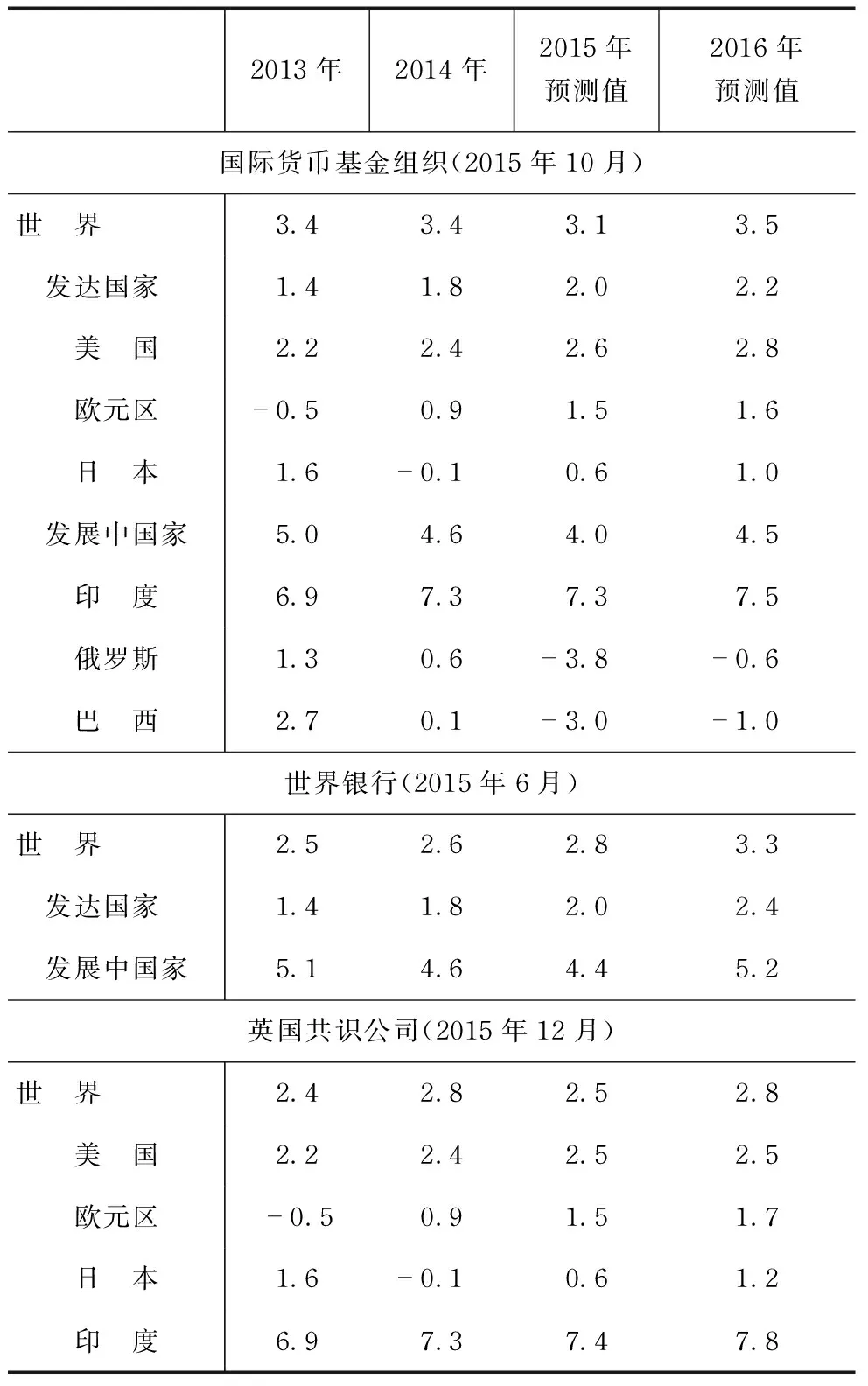
表1 世界经济增长率(上年=100) 单位:%
注:1.国际货币基金组织公布的世界及分类数据按照购买力平价方法进行汇总,世界银行和英国共识公司按汇率法进行汇总。2.印度数据指财政年度。2013年、2014年度数据为印度官方大幅上修后数据,而2015年及2016年数据系参照官方修订后数据的预测结果。3.各经济体2013年、2014年数据已据其官方发布结果作了调整。
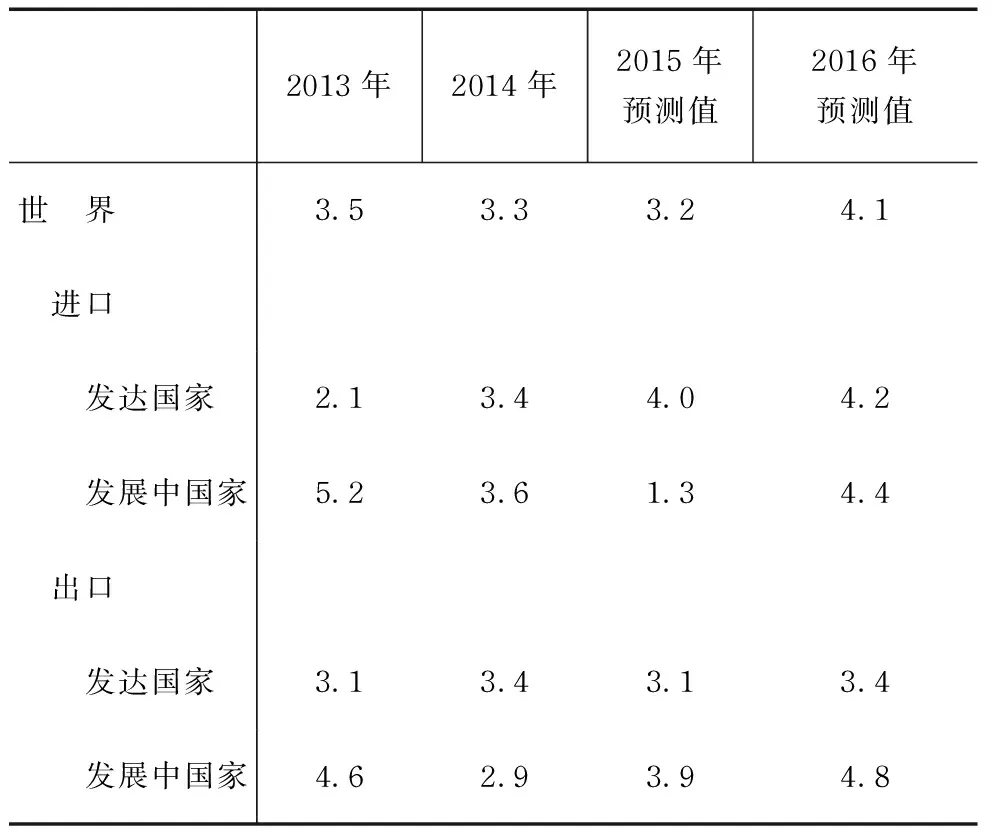
表2 世界贸易量增长率(上年=100) 单位:%
注: 包括货物和服务。
资料来源: 国际货币基金组织2015年10月预测。
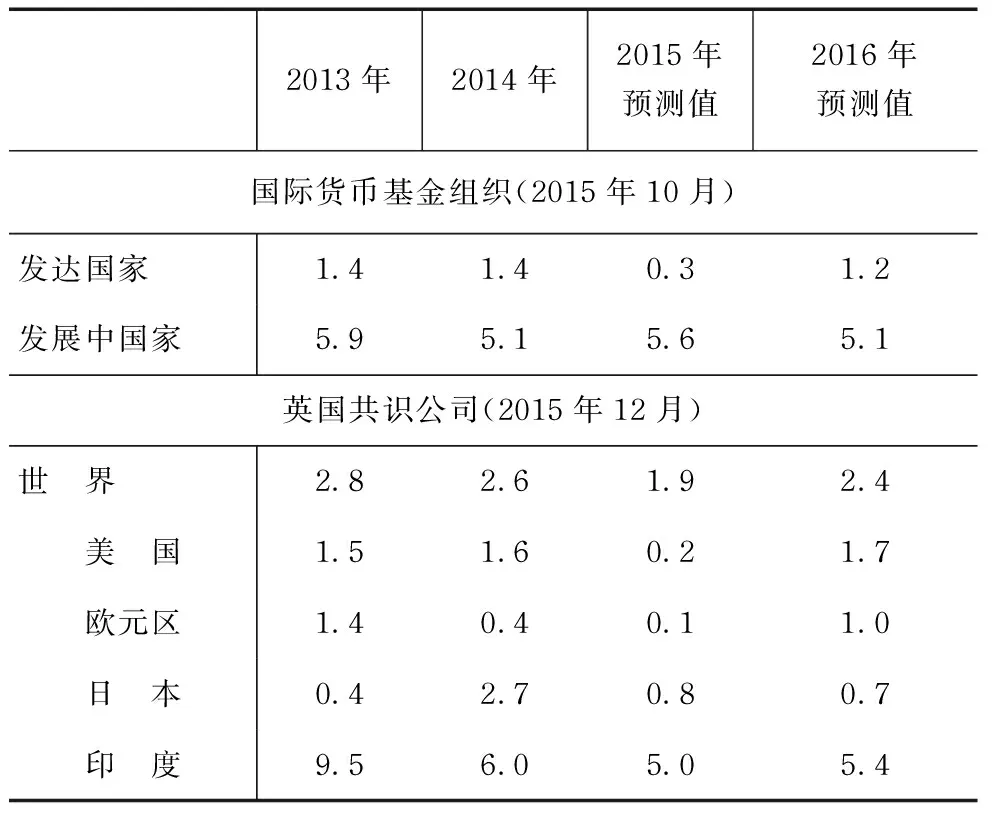
表3 消费者价格涨跌率(上年=100) 单位:%
注: 1.印度来源于英国共识公司的数据指财政年度。2.各经济体2013年、2014年数据已据其官方发布结果作了调整。
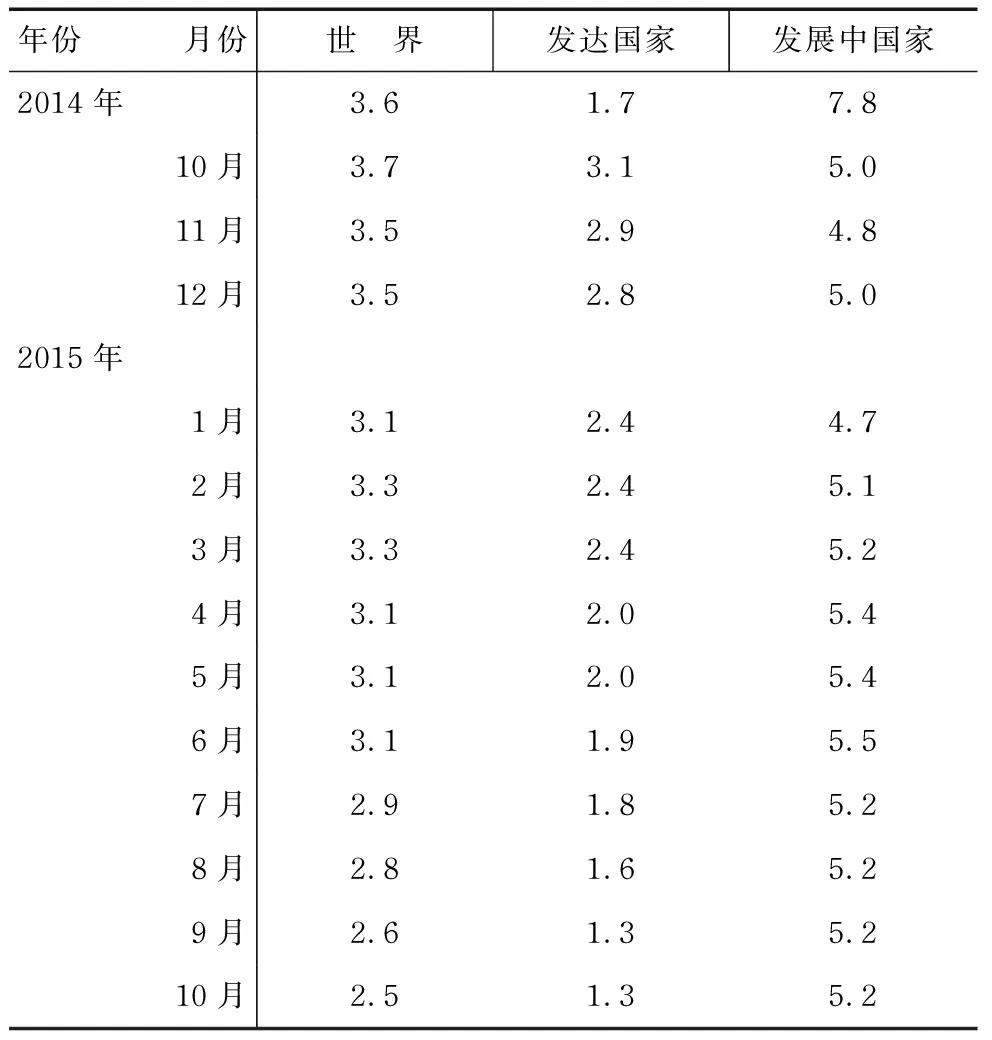
表4 消费者价格同比上涨率 单位:%
资料来源:世界银行数据库。
表5 工业生产
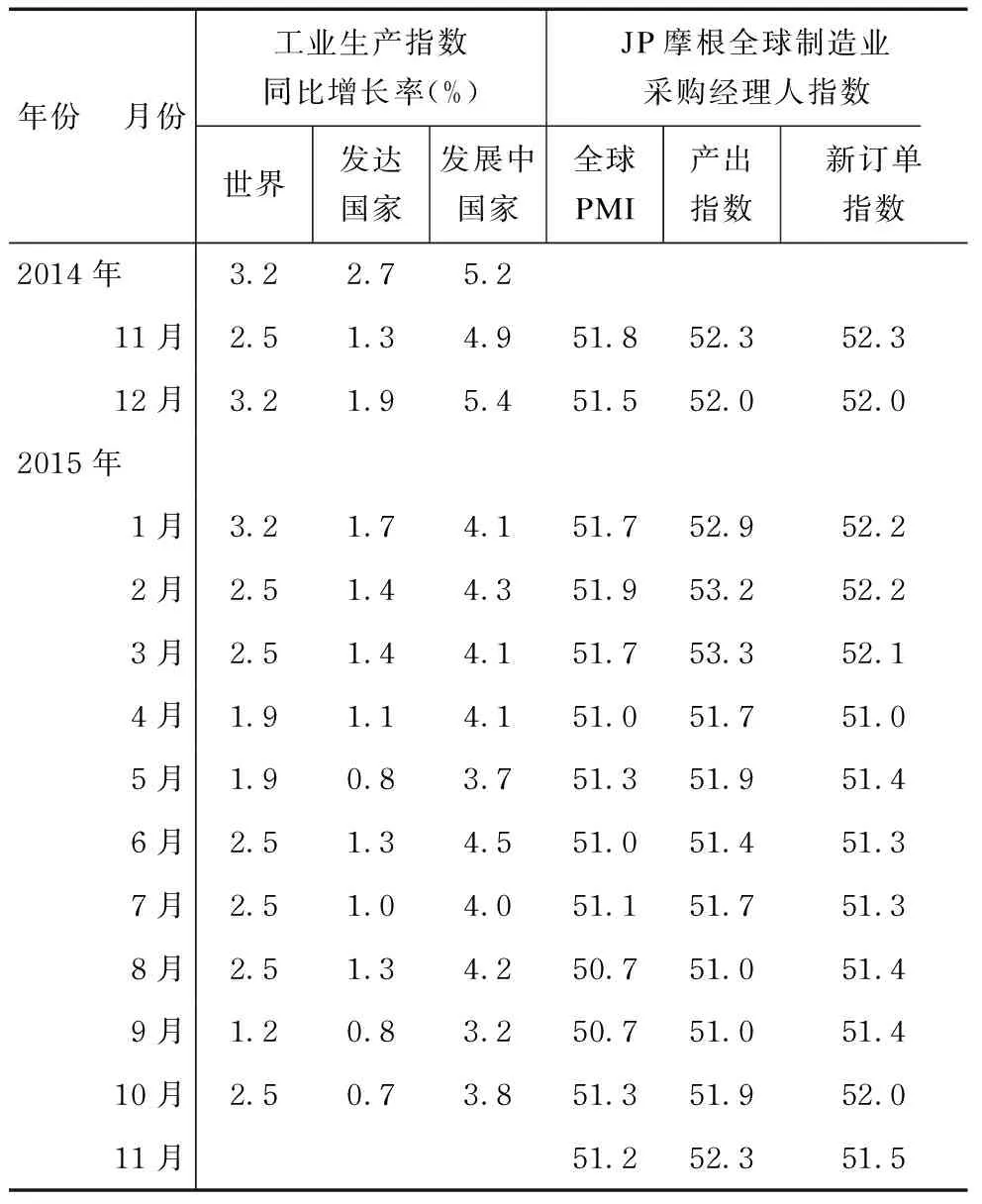
年份月份工业生产指数同比增长率(%)JP摩根全球制造业采购经理人指数世界发达国家发展中国家全球PMI产出指数新订单指数2014年3.22.75.211月2.51.34.951.852.352.312月3.21.95.451.552.052.02015年1月3.21.74.151.752.952.22月2.51.44.351.953.252.23月2.51.44.151.753.352.14月1.91.14.151.051.751.05月1.90.83.751.351.951.46月2.51.34.551.051.451.37月2.51.04.051.151.751.38月2.51.34.250.751.051.49月1.20.83.250.751.051.410月2.50.73.851.351.952.011月51.252.351.5
注:1.工业生产指数同比增长率为经季节调整的数据。2.采购经理人指数超过50预示着经济扩张期。
资料来源:世界银行数据库、美国供应管理协会。
二、美国经济
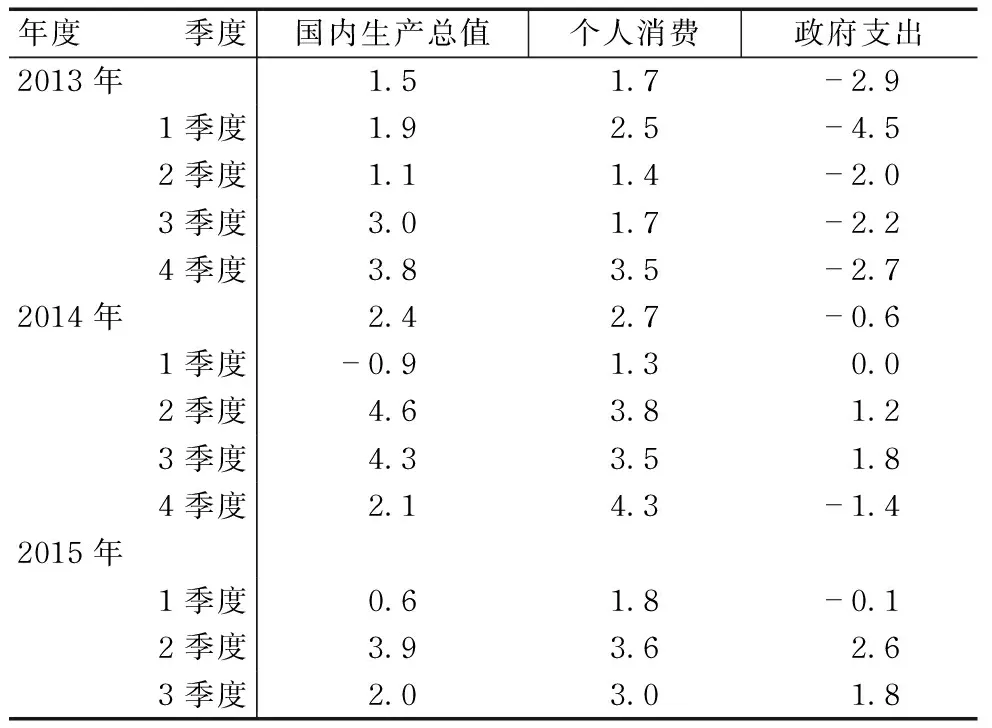
表6 国内生产总值及其构成增长率(环比) 单位:%
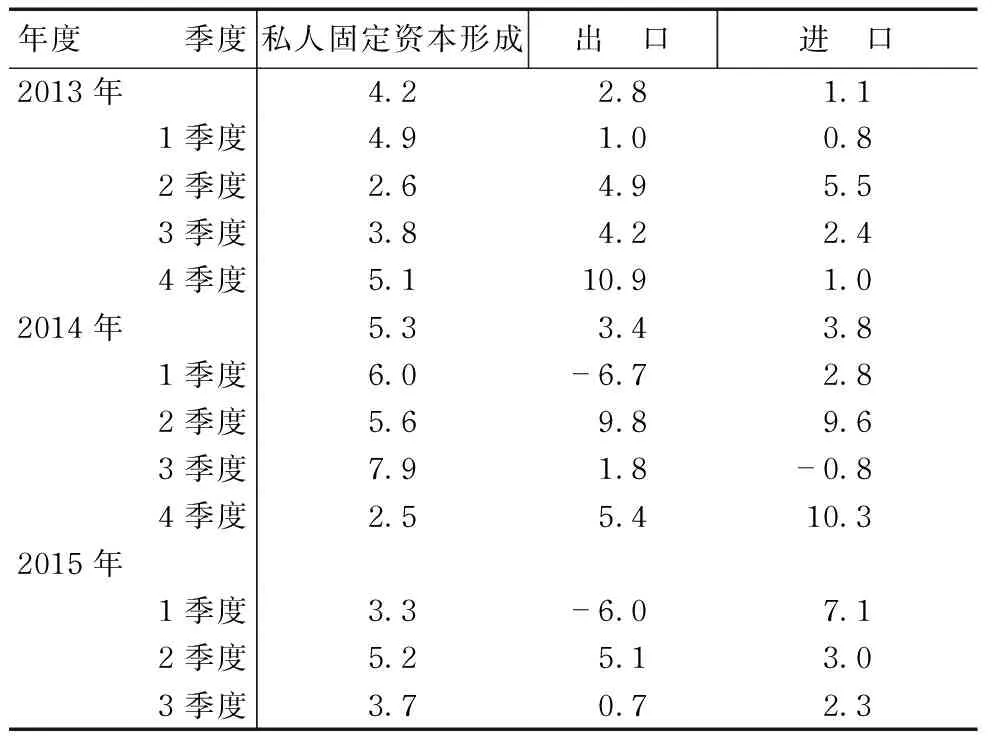
表7 国内生产总值及其构成增长率(环比) 单位:%
注:季度数据按季节因素调整、折年率计算(表6、表7)。
资料来源:美国商务部经济分析局(表6、表7)。
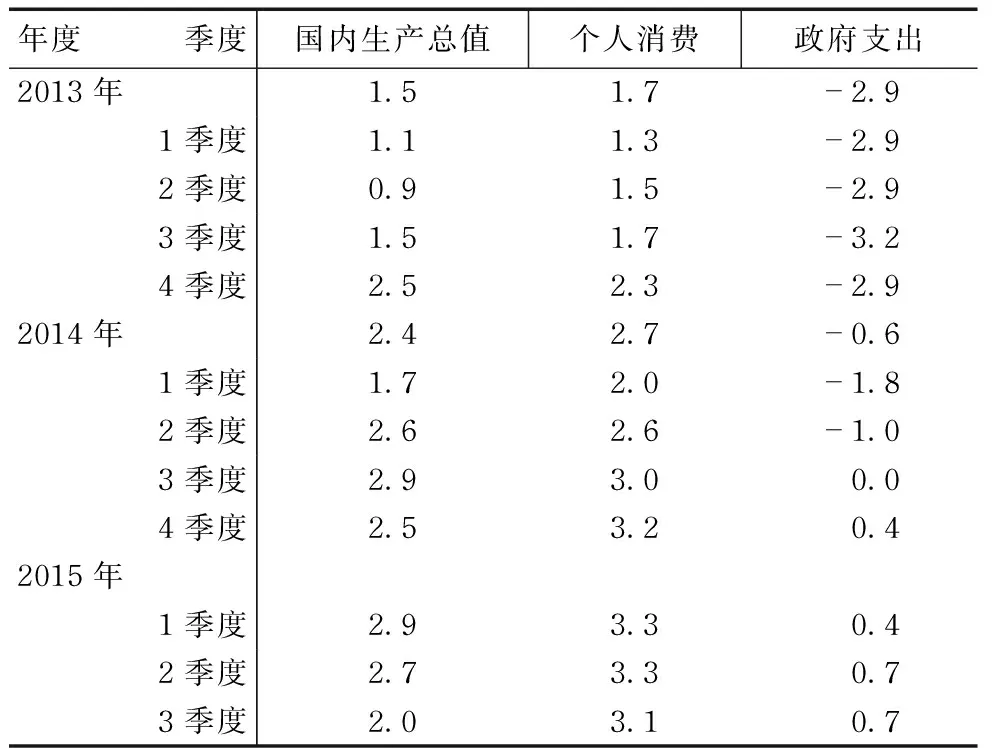
表8 国内生产总值及其构成增长率(同比) 单位:%
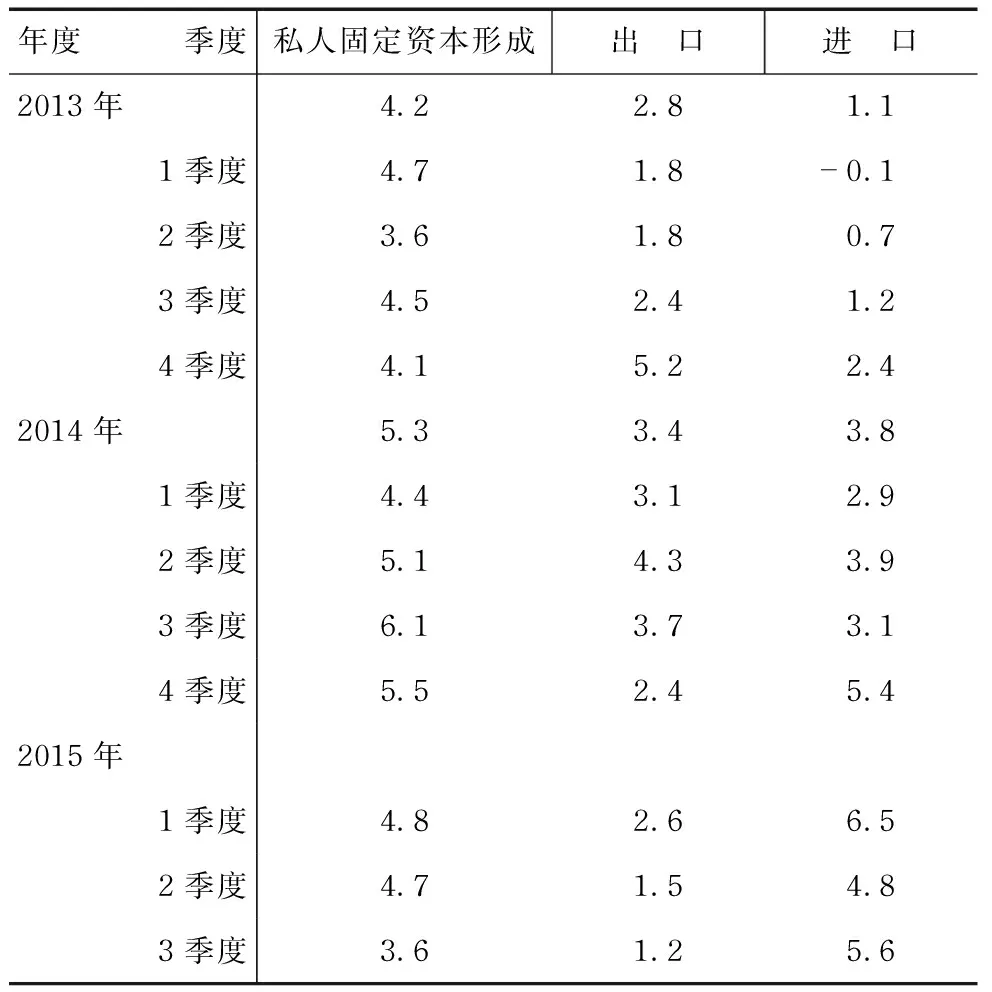
表9 国内生产总值及其构成增长率(同比) 单位:%
注:季度数据按季节因素调整(表8、表9)。
资料来源:美国商务部经济分析局(表8、表9)。
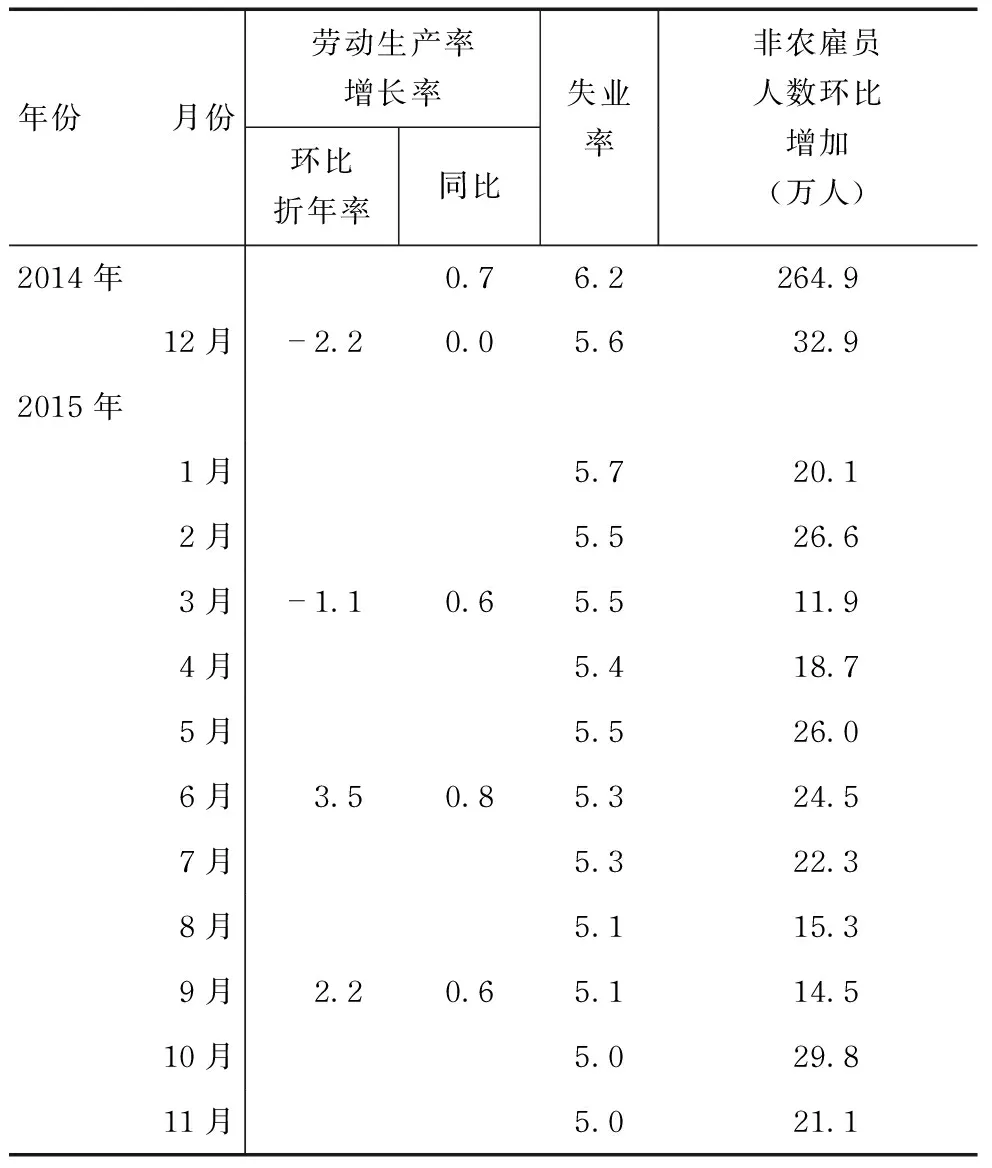
表10 劳动力市场 单位:%
注:除年度数据以外,劳动生产率增长率为该月份所在季度的增长率。
资料来源:美国劳工统计局。
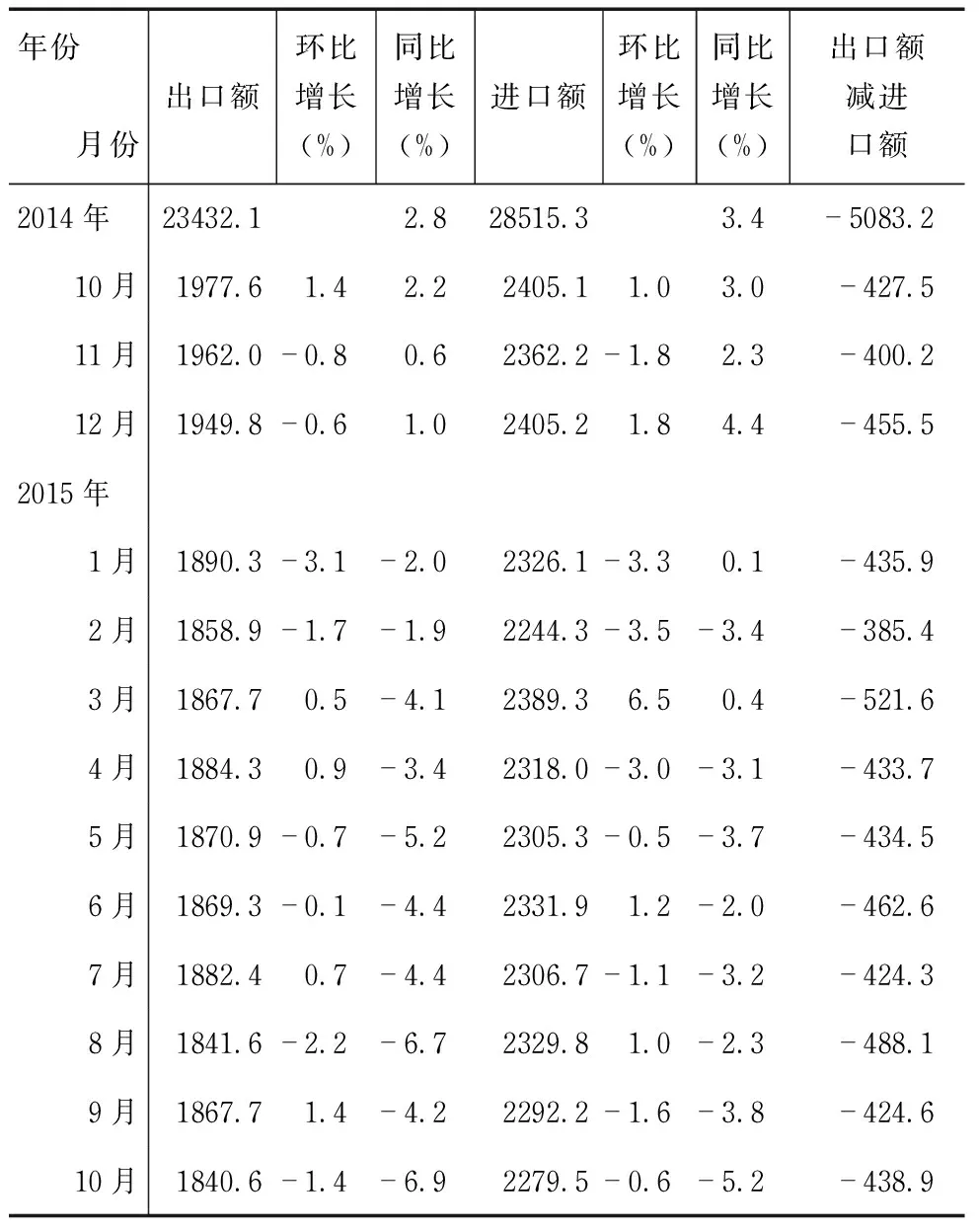
表11 进出口贸易 单位:亿美元
注:包括货物和服务贸易。因季节调整,各月合计数据不等于全年总计数据。
资料来源:美国商务部普查局。
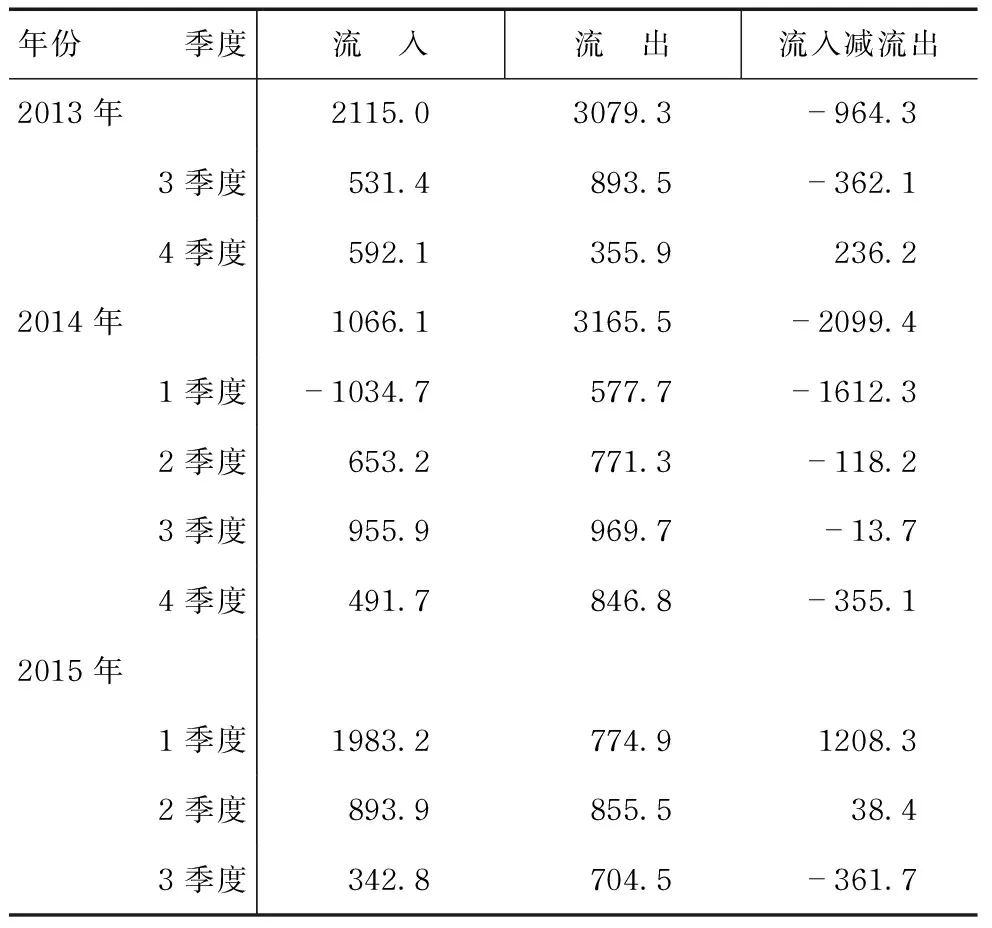
表12 外国直接投资 单位:亿美元
资料来源:美国商务部经济分析局。
三、欧元区经济
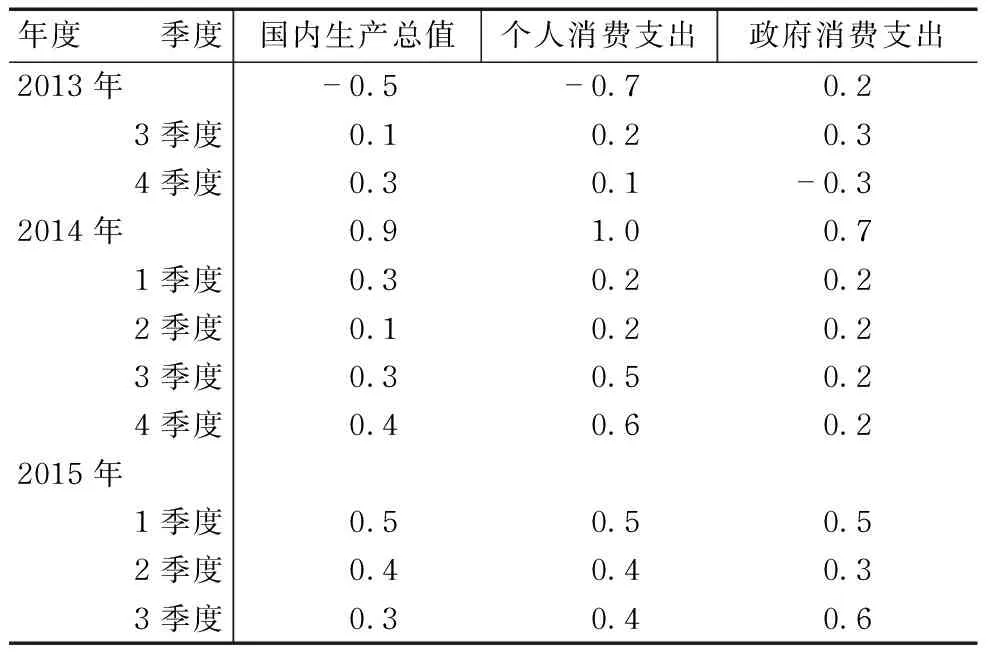
表13 国内生产总值及其构成增长率(环比) 单位:%

表14 国内生产总值及其构成增长率(环比) 单位:%
资料来源:欧盟统计局数据库(表13、表14)。
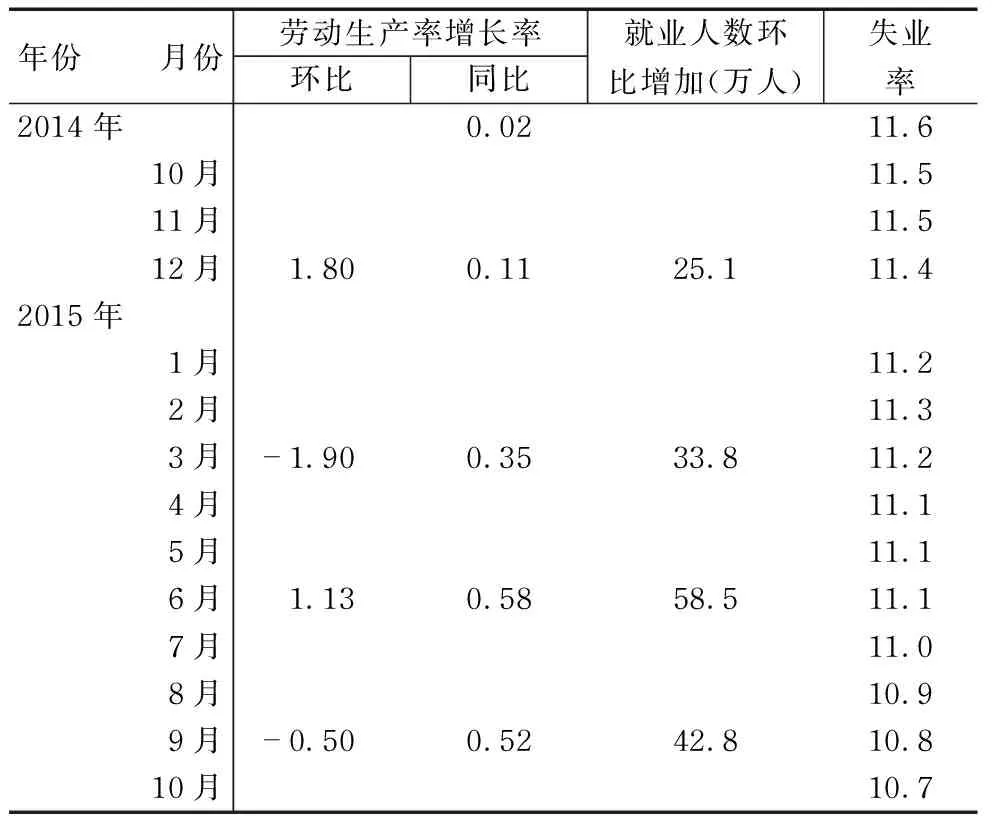
表15 劳动力市场 单位:%
注:除年度数据以外,劳动生产率增长率为该月份所在季度增长率;就业人数为该月份所在季度的环比变化。
资料来源:欧洲央行统计月报、欧盟统计局数据库。
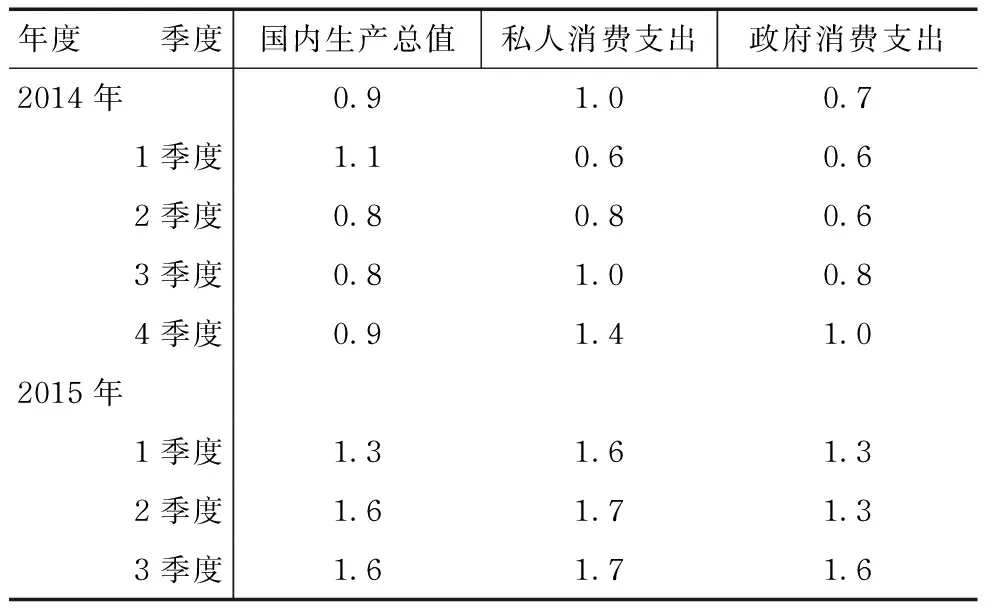
表16 国内生产总值及其构成增长率(同比) 单位:%
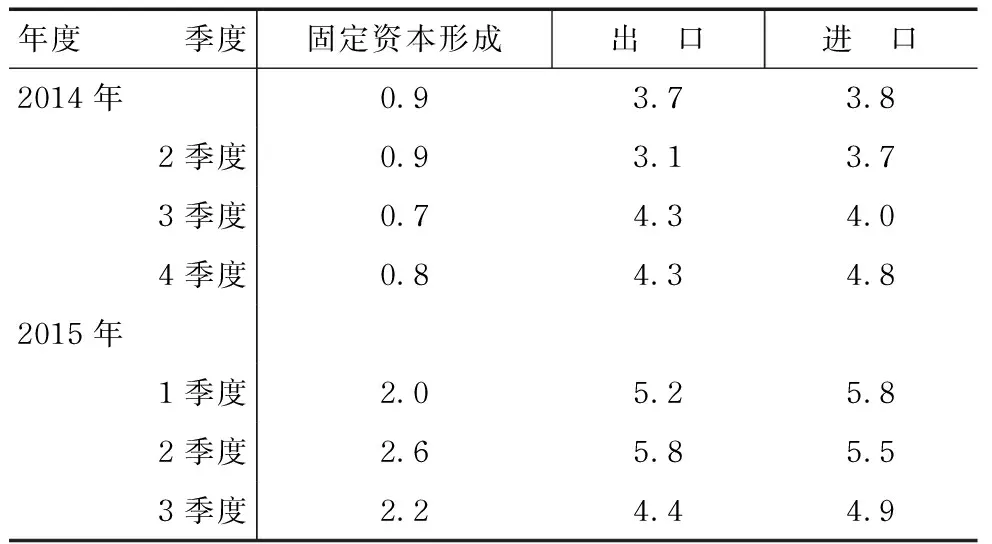
表17 国内生产总值及其构成增长率(同比) 单位:%
资料来源:欧盟统计局数据库(表16、表17)。
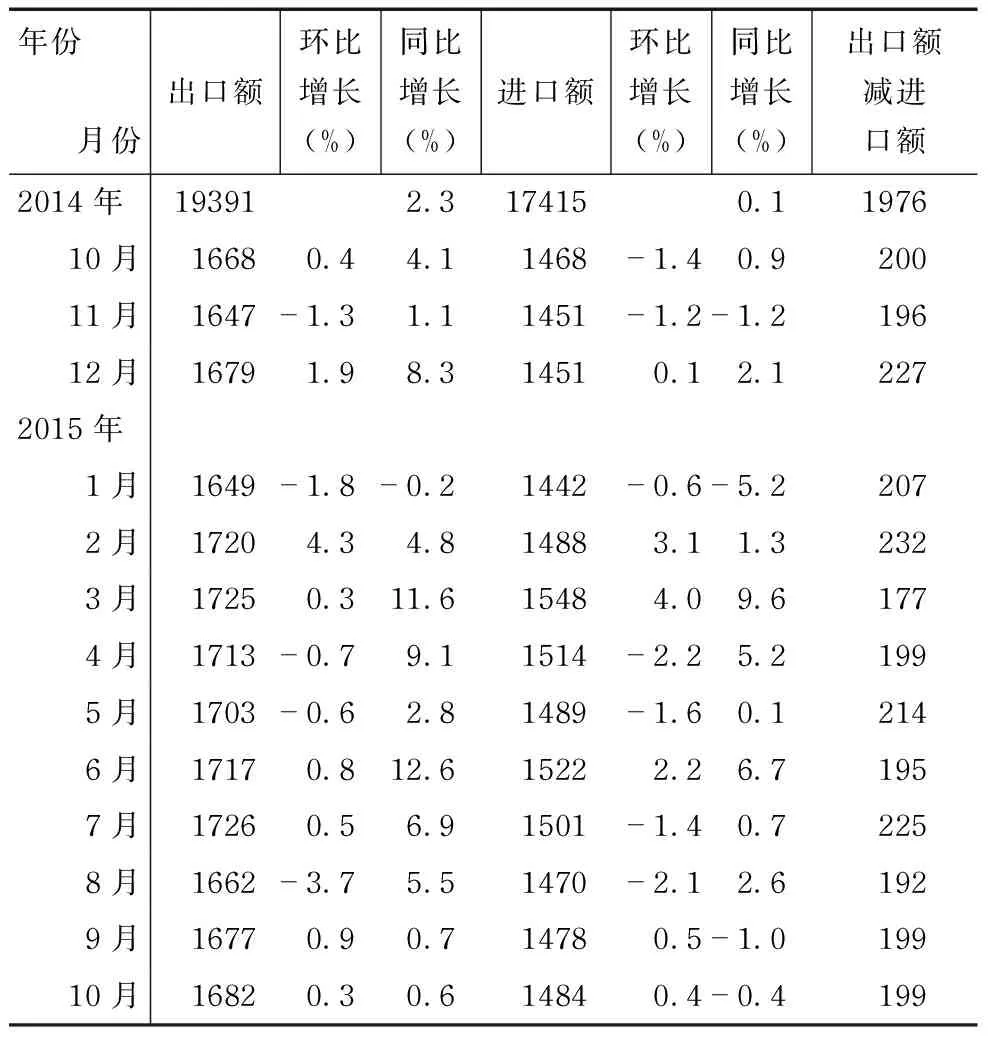
表18 进出口贸易 单位:亿欧元
注:欧元区绝对数指欧元区现有范围,即19个成员国。贸易额不包括欧元区各成员国相互之间的贸易额,为经季节调整后的数据。
资料来源:欧盟统计局数据库。
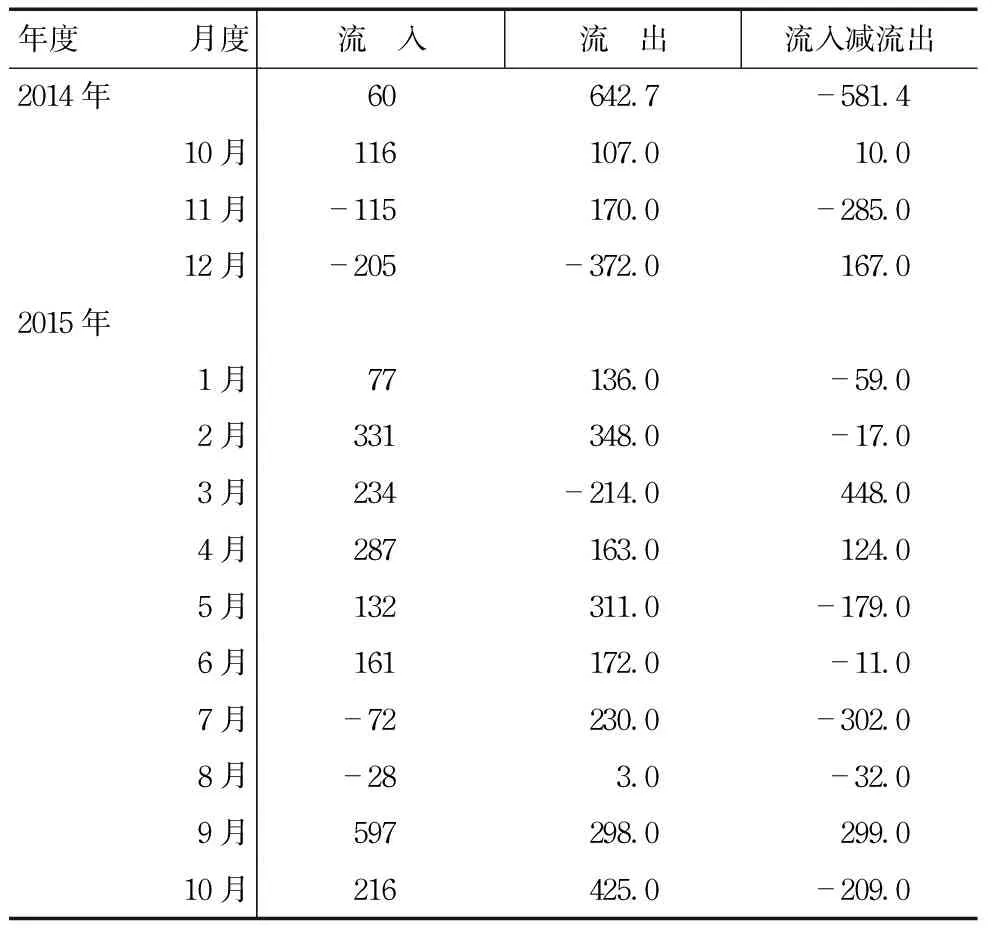
表19 外国直接投资 单位:亿欧元
注:欧元区绝对数指欧元区现有范围,即19个成员国。欧元区外国直接投资额不包括欧元区各成员国相互之间的直接投资额。
资料来源:欧洲央行统计月报。
四、日本经济

表20 国内生产总值及其构成增长率(环比) 单位:%
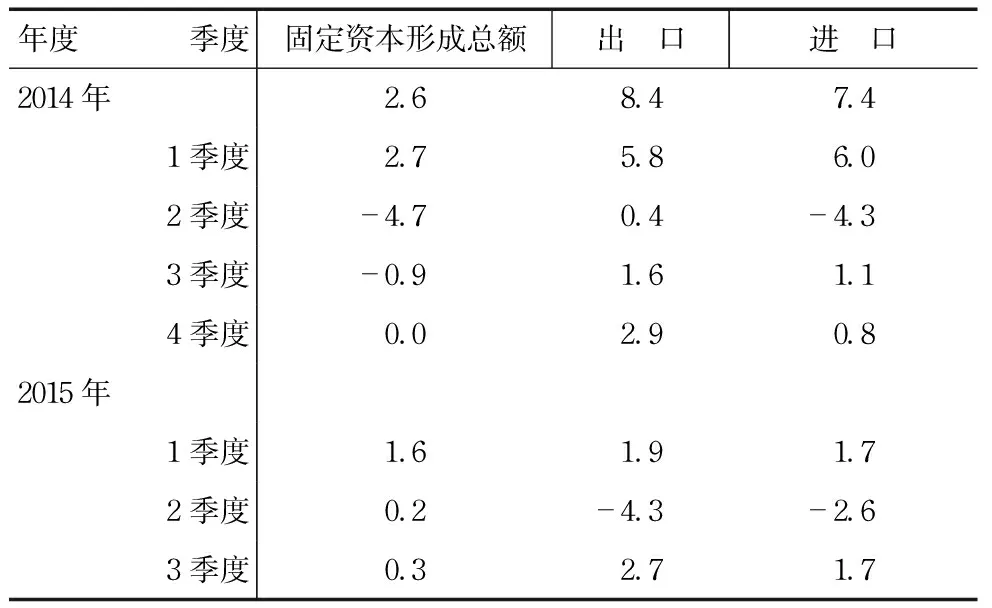
表21 国内生产总值及其构成增长率(环比) 单位:%
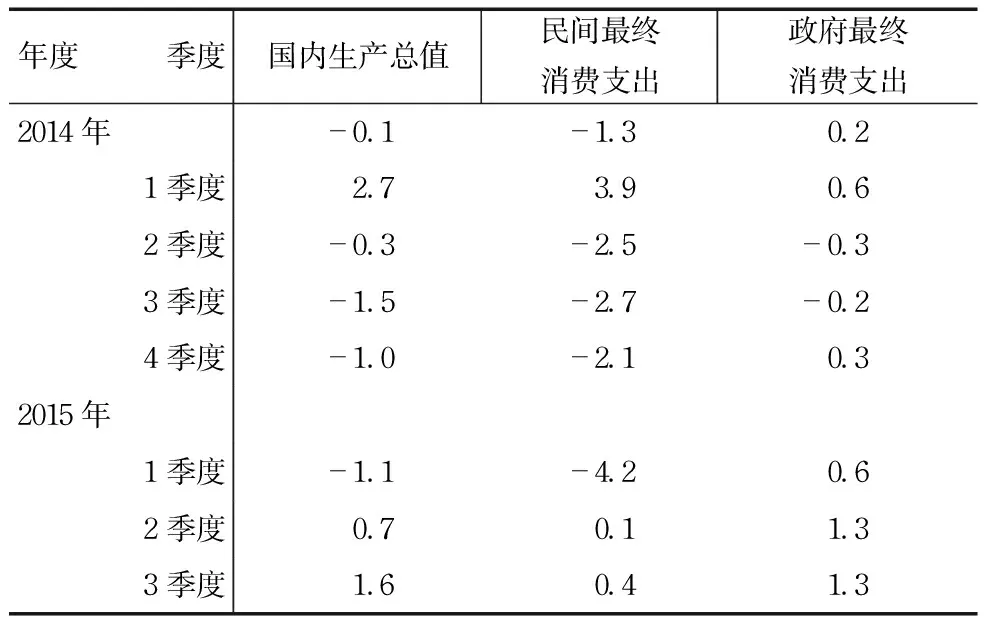
表22 国内生产总值及其构成增长率(同比) 单位:%
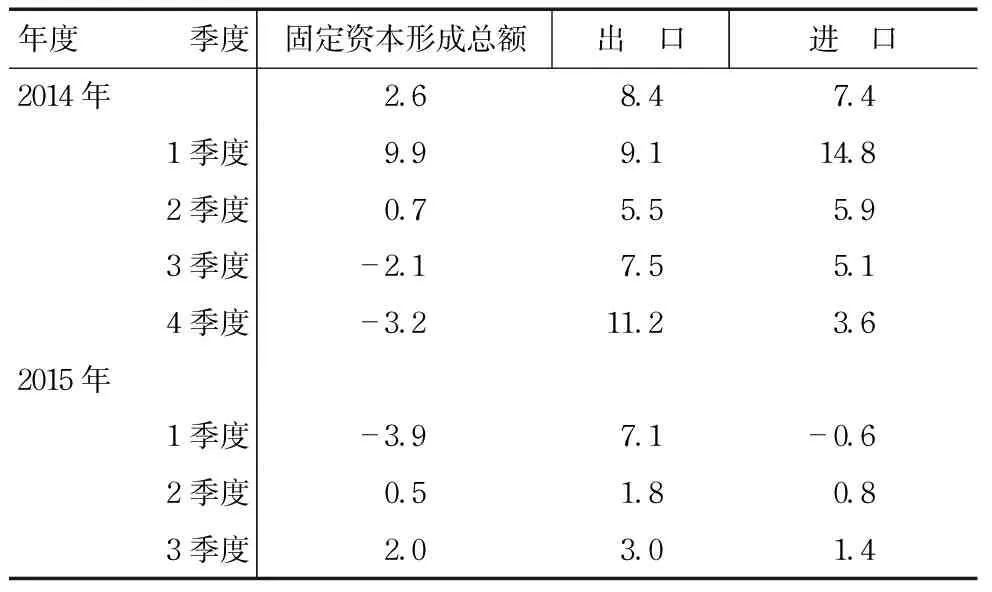
表23 国内生产总值及其构成增长率(同比) 单位:%
资料来源:日本内阁府(表20~表23)。
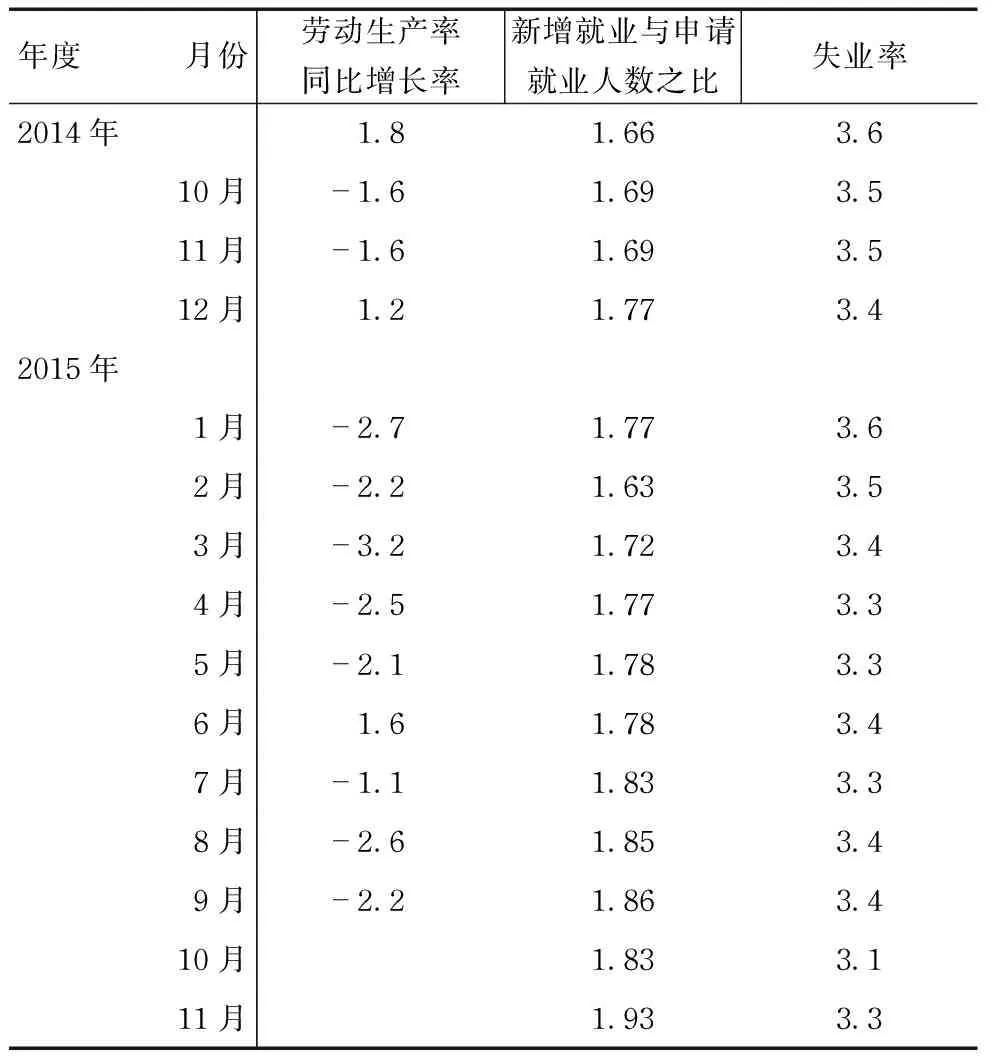
表24 劳动力市场 单位:%
资料来源:日本统计局和日本央行统计月报。
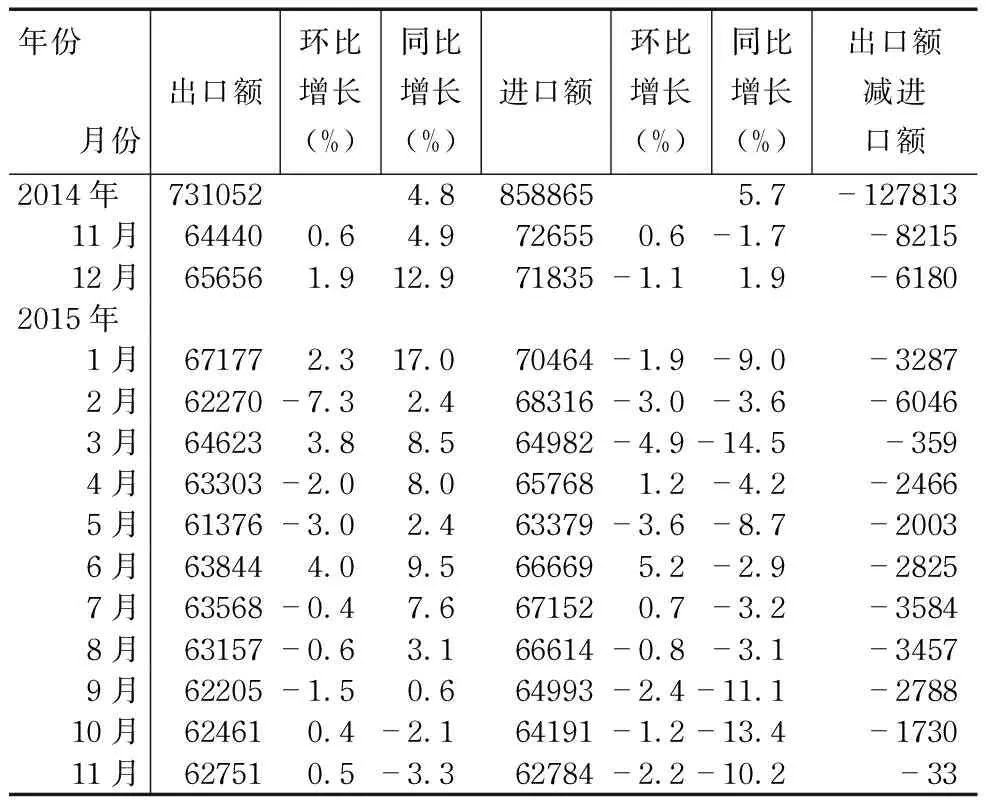
表25 进出口贸易 单位:亿日元
注:月度贸易额为季节调整后数据。
资料来源:日本财务省。
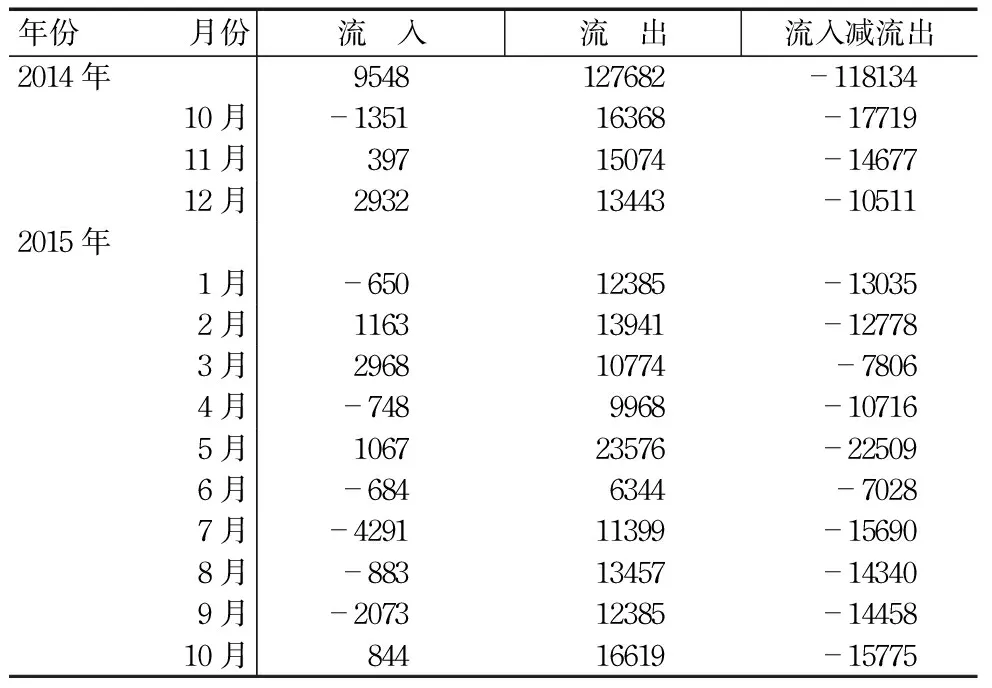
表26 外国直接投资 单位:亿日元
资料来源:日本财务省。
五、其他主要国家和地区经济
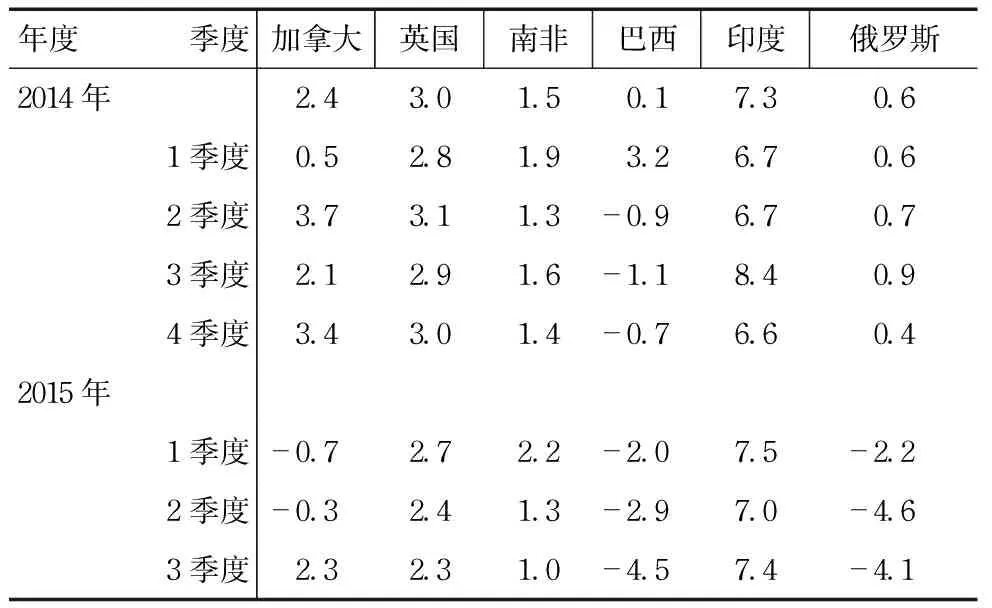
表27 国内生产总值增长率(同比) 单位:%
注:印度年度GDP增长率为财年增长率。
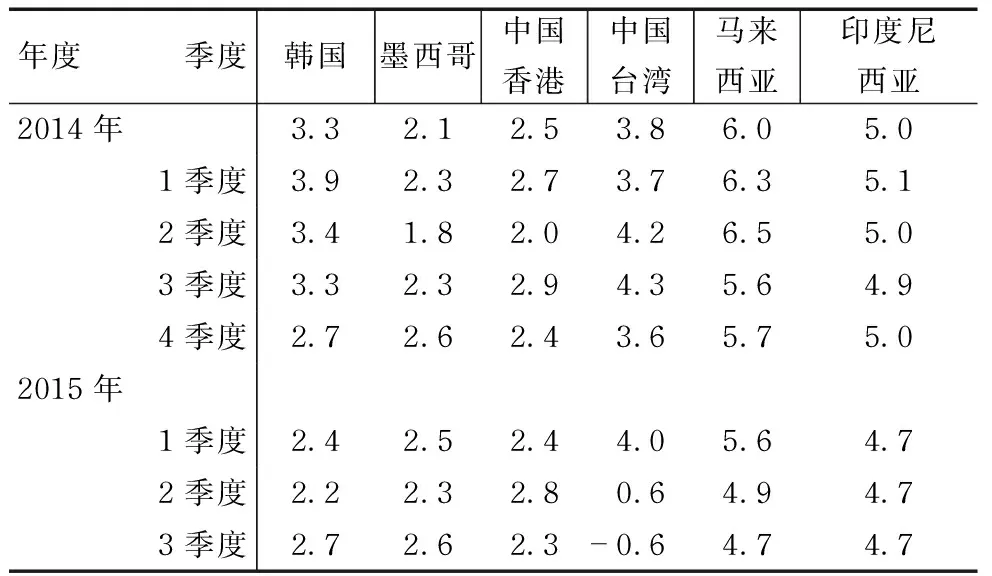
表28 国内生产总值增长率(同比) 单位:%
资料来源:各经济体官方统计网站。
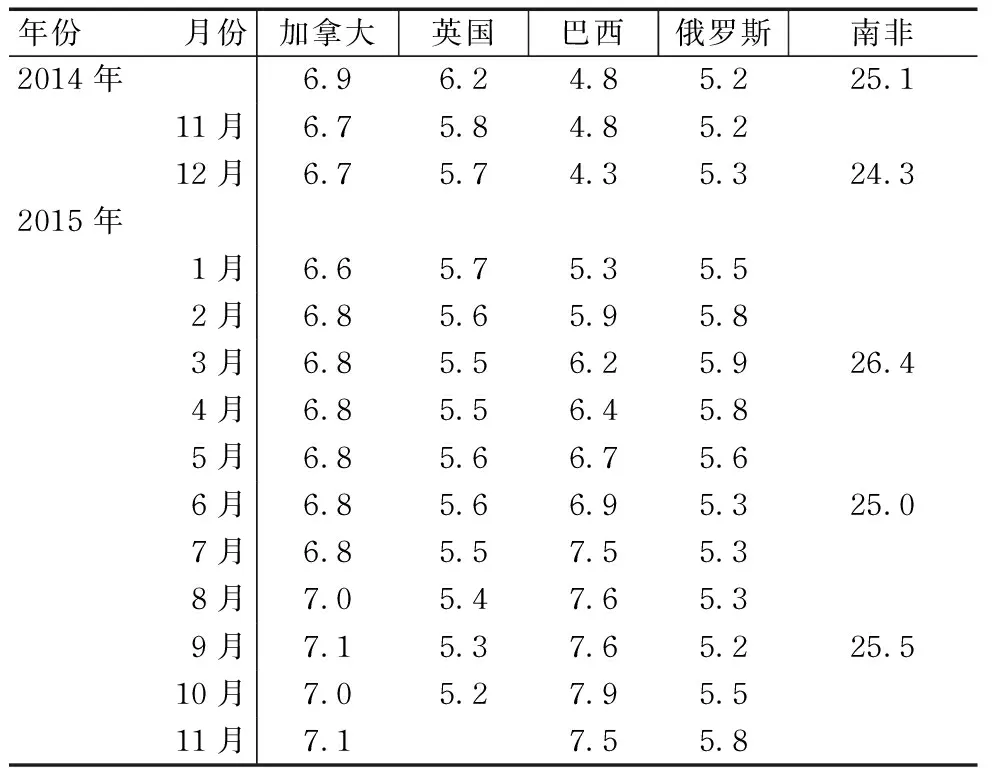
表29 劳动力市场失业率 单位:%
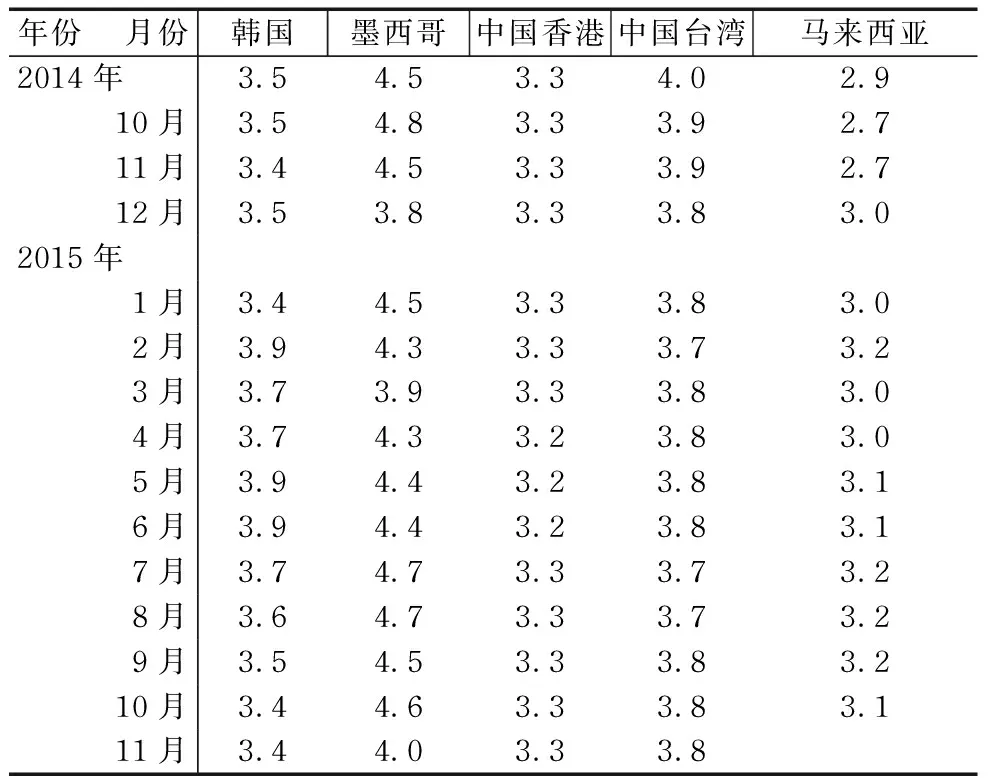
表30 劳动力市场失业率 单位:%
注:1.英国和中国香港月度数据为截至当月的3个月移动平均失业率。2.加拿大、英国、韩国和中国香港为经季节因素调整后的失业率。
资料来源:各经济体官方统计网站。
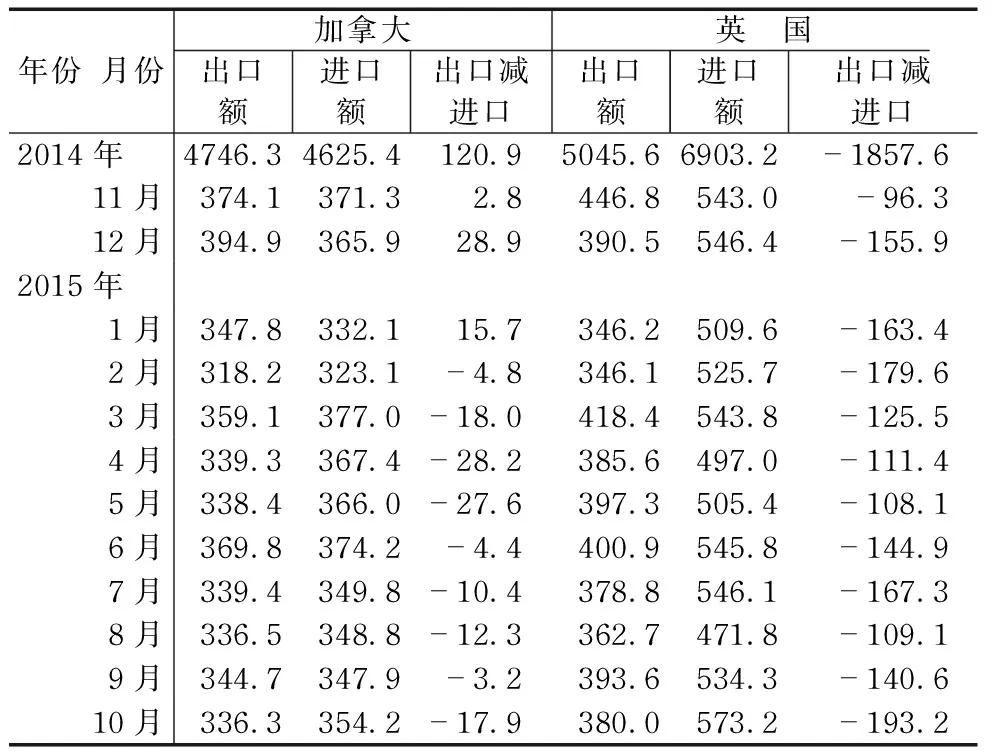
表31 进出口贸易 单位:亿美元
注:加拿大和英国数据经过季节因素调整。
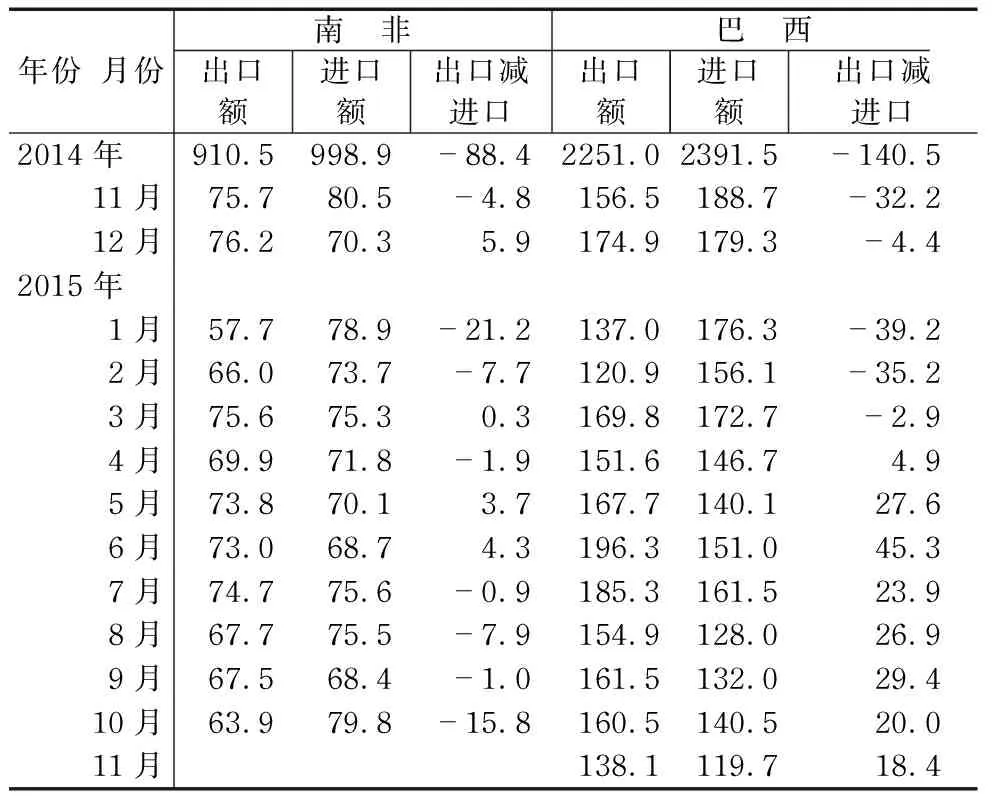
表32 进出口贸易 单位:亿美元
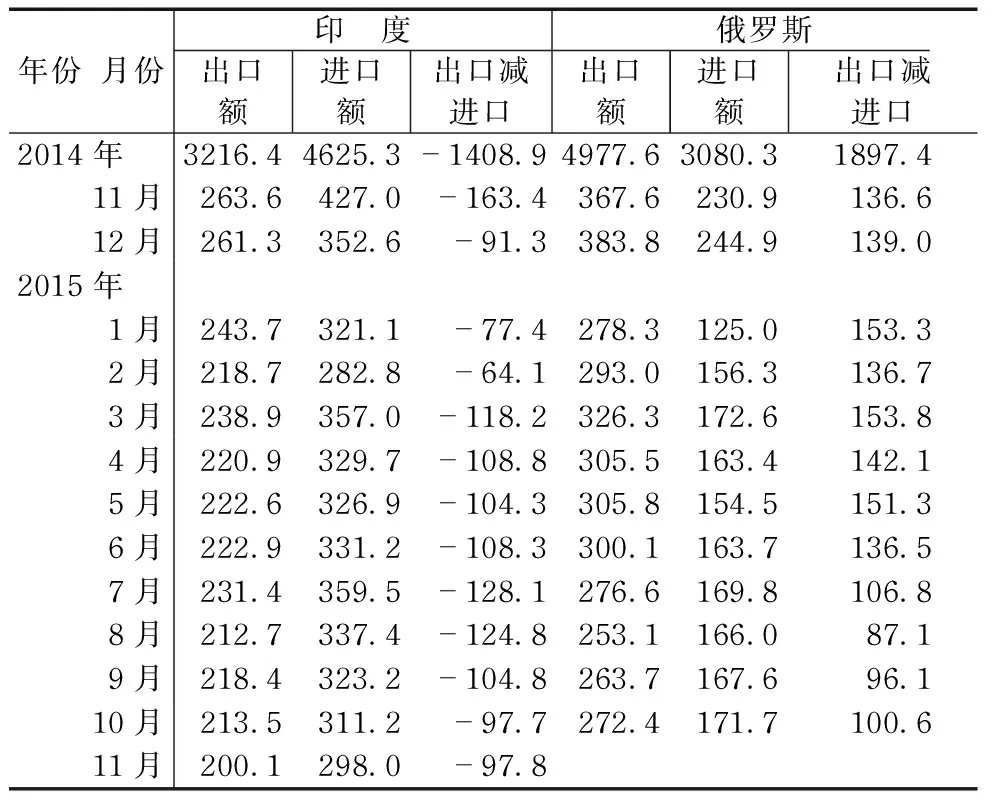
表33 进出口贸易 单位:亿美元
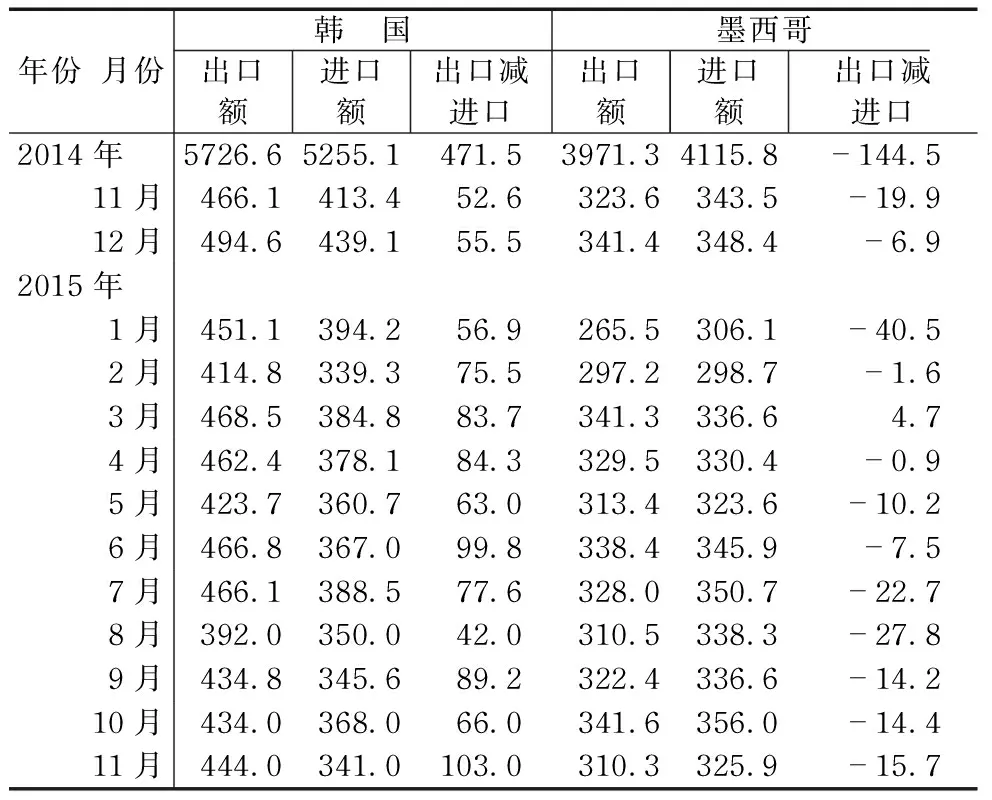
表34 进出口贸易 单位:亿美元
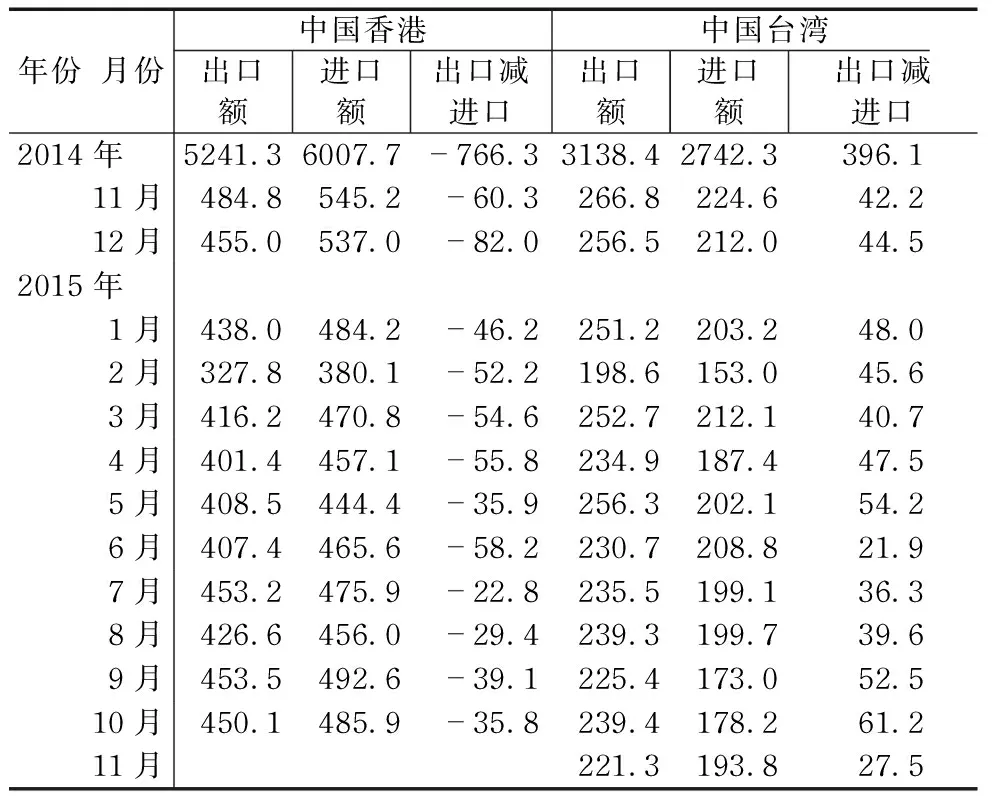
表35 进出口贸易 单位:亿美元
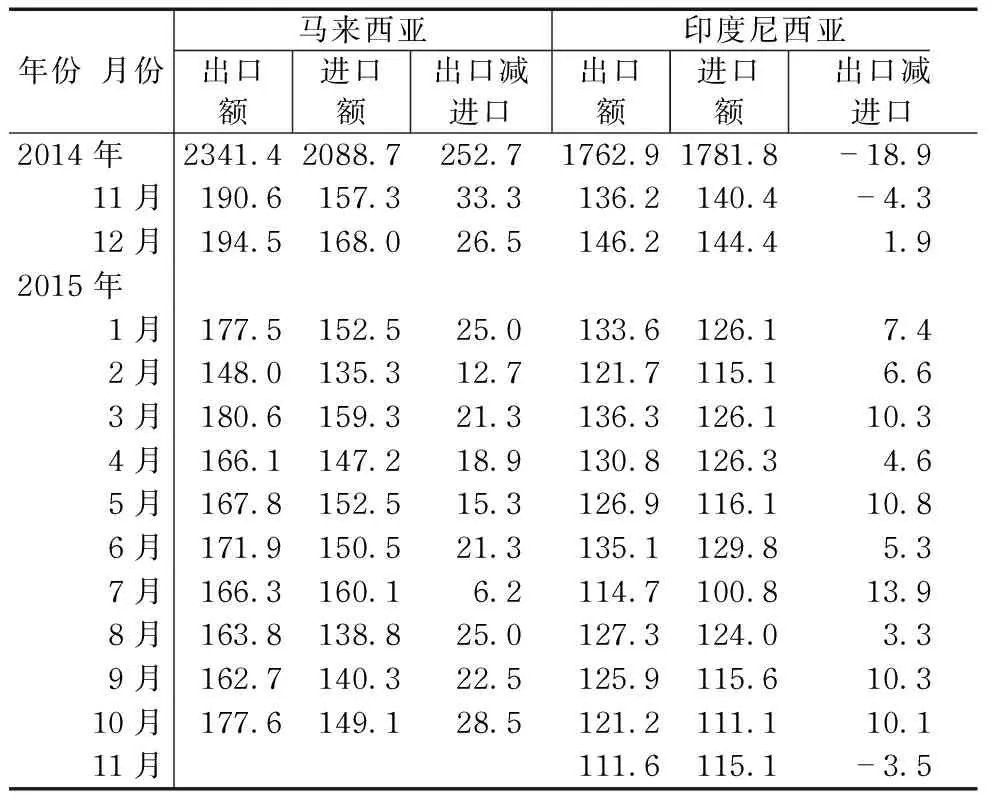
表36 进出口贸易 单位:亿美元
资料来源:各经济体官方统计网站(表27~表36)。
六、三大经济体指标对比图

图1 三大经济体GDP环比增长率(%) 注:美国为环比折年率增长率。

图2 三大经济体失业率变动(%)

图3 三大经济体出口额同比增长率(%)

图4 三大经济体进口额同比增长率(%) 数据来源:各经济体官方统计网站(图1~图4)。
责任编辑:陈璇璇
S
(1) The Analysis of World Economy Trend in 2015 and Outlook on 2016
Chen Wenling Yan Shaojun
From 2015 to 2016, the world economic recovery is still slow, still in the slow growth of the “new normal.” Economy, politics and diplomacy under profound changes intertwined, and the world still stayed in the periods of turbulence, transition, change and adjustment. World Economy performed as “three lows” and the “three imbalances”, the major economies has obvious differentiations, macroeconomic policy game including currency, finance and trade between the major powers had become an important variable affecting world economic growth. The uncertainty of world economic growth increased. This requires us to grasp the development trend of the world economy and China’s economy, and implement a better opening-up strategy to address current challenges and fight for a better future, and strive for greater national interests in the stage of international cooperation and competition.
(2)Great Achievements of China in the period of the 12th Five Year Plan
Lin Zhaomu
During the period of the 12th Five Year Plan, facing the complex domestic and international environment, our Party has led people of all nationalities to make great achievements in economic, political, military, cultural and other aspects, which had laid a solid foundation for building a well-off society and had significant and far-reaching significance for the realization of two “one-hundred-year” goals.
(3)Sovereign Wealth Funds as International Institutional Investors: a Reevaluation (2008-2013 Survey)
Meng Chen, Jiang Chunyang
This paper provides a clear definition of Sovereign Wealth funds (SWFs) that differentiates them from similar institutions. It adds to the analysis of SWF behavior by using the lens of the theory of the multinational enterprise. A comprehensive survey of the international investment behavior of SWFs is undertaken that shows the funds to be largely conservative in their investment policies and non-strategic in investment approaches. Policies towards SWF are recommended that take account of their particular characteristics but are neutral with regard to their international investment behavior.
(4)Analysis and Outlook of Global Services Situation
Wang Xiaohong,Li Yongjian
In recent years, affected by the slow world economic recovery at sluggish growth, the global services industry has maintained steady low growth, extremely with uneven levels of development; cross-border investment keeps steady with a slight decrease, but still holding the dominant position; global trade in services remain robust in low growth, still better than the overall growth in world trade; policy innovation accelerates with the Internet becoming the main force. At the same time, the new trends will emerge in these ways: the development of Internet driving the global services industry into continuous innovation, Internet banking providing new impetus and a new model for the financial industry, crowdsourcing model becoming the new engine for growth in the service outsourcing industry, the intelligent manufacturing becoming the new trend in manufacturing Servitization, sharing economy becoming a new model of service development, big data and e-commerce and other new industry maintaining strong growth momentum. In 2015-2016 service industry will make a flat and low increase with about 3.2% to 3.5%, its proportion occupying about 70% in the whole GDP.
(5)Impelling RMB Internationalization with a New Round of Capital Account Opening
Ye Zhendong
After the international financial crisis, the voice of the international monetary system reform brings important strategic opportunities for the RMB internationalization. China is to build a comprehensive new system of open economy, with the efforts from all aspects of economic, financial, institutional and other rules, in order to seek international status with its matched power. With China’s “One Belt One Road” strategy gaining widespread and profound influence in the international community, the internationalization of RMB is expected to accelerate in the future. This paper analyzes the implications of RMB internationalization, determinants, benefits and risks. With a comprehensive of domestic and international research, based on the review of China’s capital account liberalization, it pointed out that a low degree of openness of the capital account is currently the most important factor to limit the internationalization of RMB, and analyzes the current situation of subitems of capital projects. In order to promote the internationalization of the RMB, we propose accelerating a new round of capital account liberalization, and properly handling the “three questions”, focusing on broadening RMB circulation channels to promote the construction of RMB securities markets, activate two-way direct investment, and improve the relevant supporting reform measures.
(6)Current Situation of China’s utilization of foreign investment in the 12thFive-year Plan period and strategic choice in the 13thFive-year Plan Period
Li Rui
In the 12thFive-year plan period, the world is in slow and difficult recovery after the international financial crisis, while FDI is also in fluctuated state. China’s FDI scale has been in sustainable development, industrial structure of utilization of foreign capital has been further improved, and regional distribution imbalance has been eased. With the continuous adjustment of state policies in utilization of foreign capital, China’s FDI scale, quality and efficiency has been continuously improving, thus China has become the largest Destination Country of FDI. Meanwhile, China’s utilization of foreign investment remains rising costs, uneven distribution and low efficiency. In “Thirteenth Five-year” period, foreign industrial layout is to be optimized for pushing up the value chain to the high-end; regional distribution of foreign investment shall be optimized for promoting balanced regional development; global high-end production factors gathering capacity is to be improved in enhancing innovation capacity; and a sound investment environment shall be created for encouraging investment liberalization facilitation.
(7)Thinking on the Current China’s Economy
Li Luoli
China’s current economic downturn is so clear that we need to consider more on its long-term development of the situation and the fact that the nature of serious consideration. Although the economy into some difficulties, but difficulties just develop it, not a crisis but not collapse. Current issue fundamentally beneficial long-term sustainable development, the key historical periods because the Chinese economy has been the need to transition. The current economic downturn phenomenon is bound to have and implement restructuring faced, the key is the correct solution. Observation of a country’s economic growth rate is reasonable, mainly to see its growth rate can meet the employment rate. Only the traditional economic indicators to determine trends and long-term development of the real economy, is no longer accurate and objective, the need for new indicators to analyze and research on new economic form. Analysis of the investment rate and consumption rate is reasonable, you must look at the nature of the phenomenon in depth. China’s current economy continues to improve, mostly with great innovation ability and enthusiasm. Various information data on e-commerce, to a certain extent can be an important indicator to observe today’s new economic form.
(8)Reform of the Housing Accumulation Fund System under the “New Normal”Situation
Cao Wenlian, Deng Zhihua, Fang Zheng
China’s development into the new normal, housing provident fund system is difficult and time. To promote its reform, we must fully understand the “quasi public goods” nature of the housing provident fund, and create a new type of housing provident fund system with Chinese characteristics. Should base on the national conditions, pay close attention to the justice, broaden coverage, to accelerate the formation of its redistribution function of the provident fund accumulation system; the focus for the low-income groups, a moderate expansion of fund use, accelerate the construction of housing policy financial system; to promote public information, improve the regulatory system, the establishment of rights and responsibilities clear, clean and efficient fund management system; to properly resolve the issues left over from history and the conflicting interests of the parties, carefully designed, implemented step by step, and strive to achieve provident fund system transformation in 3-5 years.
Editor:Guo Zhouming
